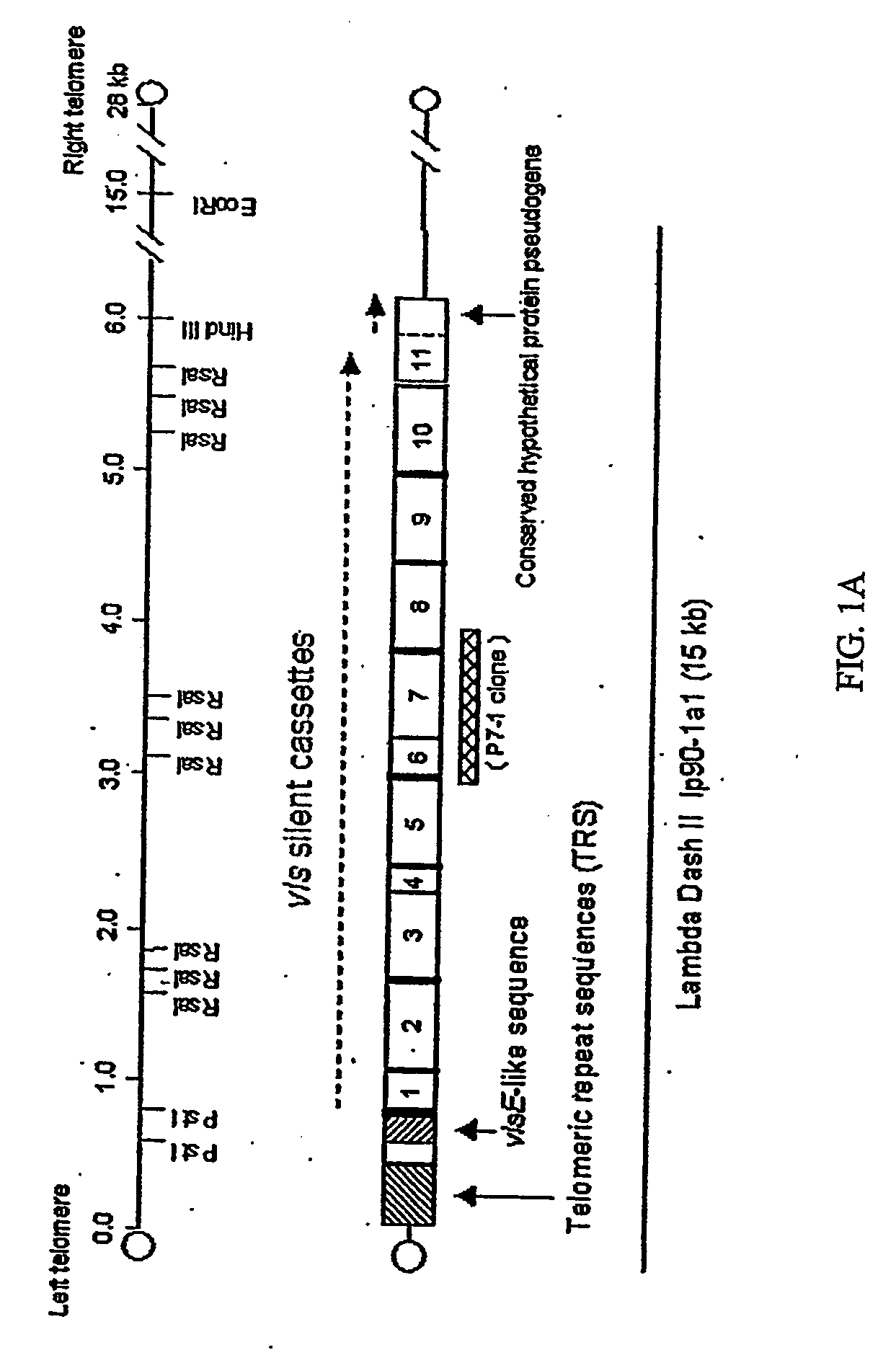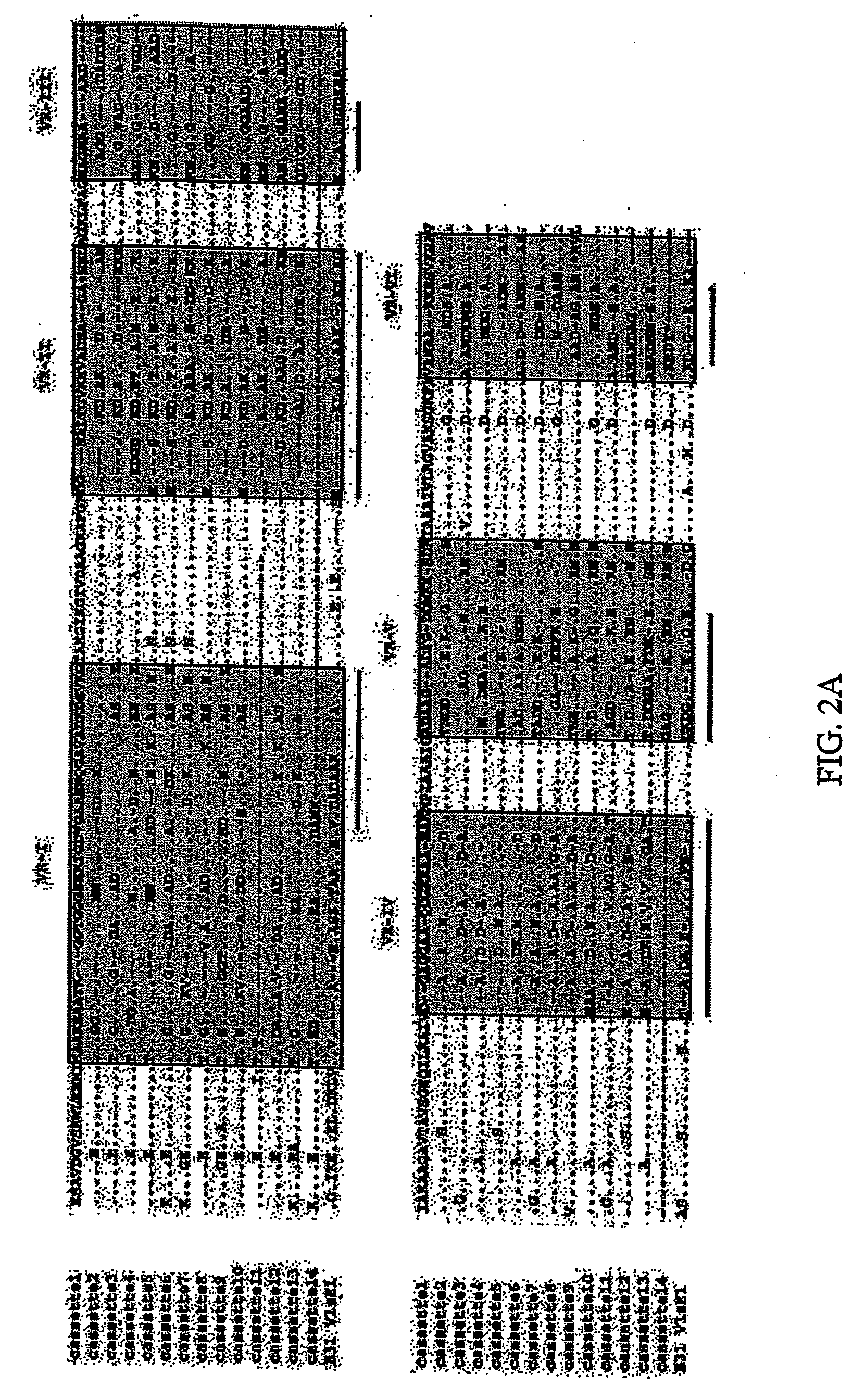Vmp-like sequences of pathogenic borrelia species and strains
a technology of pathogenic borrelia and vmplike sequences, applied in the field of molecular biology, can solve the problems of refractory treatment and difficult diagnosis of lyme diseas
- Summary
- Abstract
- Description
- Claims
- Application Information
AI Technical Summary
Benefits of technology
Problems solved by technology
Method used
Image
Examples
example 1
Experimental Procedures
[0183] Bacterial Strains
[0184]B. garinii Ip90 was initially isolated from ticks collected in eastern Russia (Kriuchechnikov et al., 1988). B. afzelii ACAI was cultured from a patient in Sweden with acrodermatitis chronica atrophicans (Asbrink et al., 1984). Both strains were graciously provided by Dr. Alan Barbour, University of California at Irvine School of Medicine, and had been passed through C3H / HeN mice to assure infectivity. Strains were passaged in vitro fewer than 5 times following mouse infection.
[0185] DNA Cloning and Sequencing
[0186] Plasmid DNA was purified from the Borrelia strains as described previously (Purser and Norris, 2000). λ DASH II libraries of plasmid DNA fragments were prepared as described by Zhang et al. (Zhang et al., 1997), with minor modifications. Thirty micrograms of plasmid DNA was treated with 30 units of mung bean nuclease at 30° C. for 30 min to hydrolyze hairpin loops in telomeres, and an EcoRI linker (5′-CCGGAATTCCGG...
example 2
Identification of vls Loci in B. garinii Ip90 and B. afzelii ACAI
[0197] Hybridization with the B. burgdorferi B31 vls silent cassette sequence in recombinant plasmid pJRZ53 was used as a means of identifying the plasmids and DNA fragments containing vls sequences in B. garinii Ip90 and B. afzelii ACAI. The pJRZ53 probe hybridized exclusively to plasmids with an approximate size of 28 kb in both ACAI and Ip90. Following treatment of plasmid preparations with restriction enzymes, the major hybridizing DNA segments were identified as a 15 kb EcoRI fragment of ACAI DNA and a 20 kb EcoRI fragment of Ip90 plasmid DNA. Libraries of plasmid DNA EcoRI fragments were prepared in Lambda Dash II using a technique that permits the cloning of telomere-containing as well as internal fragments through treatment of the hairpin loop telomeres with mung bean nuclease followed by ligation with EcoRI linkers (Zhang et al., 1997). The phage libraries were screened by hybridization with pJRZ53, and clon...
example 3
Organization of vls Silent Cassette Loci
[0198] The overall organization of the vls silent cassette loci of Ip90 and ACAI is shown in FIG. 1. As was the case in B. burgdorferi B31, the silent cassette loci in each strain was composed of a contiguous array of multiple cassettes. The loci in Ip90 and ACAI consisted largely of contiguous, uninterrupted open reading frames, with one frameshift present at the 3′ end of cassette 9 in ACAI. The B31 vls silent cassette locus contained one stop codon and two frame shifts (Zhang et al., 1997).
PUM
| Property | Measurement | Unit |
|---|---|---|
| Fraction | aaaaa | aaaaa |
| Fraction | aaaaa | aaaaa |
| Fraction | aaaaa | aaaaa |
Abstract
Description
Claims
Application Information
 Login to View More
Login to View More - R&D
- Intellectual Property
- Life Sciences
- Materials
- Tech Scout
- Unparalleled Data Quality
- Higher Quality Content
- 60% Fewer Hallucinations
Browse by: Latest US Patents, China's latest patents, Technical Efficacy Thesaurus, Application Domain, Technology Topic, Popular Technical Reports.
© 2025 PatSnap. All rights reserved.Legal|Privacy policy|Modern Slavery Act Transparency Statement|Sitemap|About US| Contact US: help@patsnap.com



